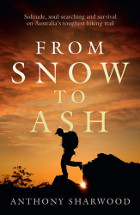From snow to ash by Anthony Sharwood

Hachette, 2020. ISBN: 9780733645280.
(Age: Senior Secondary) The Australian Alps Walking Track (AAWT)
stretches 600km from Gippsland to Canberra, a five to seven week
hike that few attempt in its entirety. Journalist Anthony Sharwood's
Dad introduced him to hiking and skiing, developing a lifelong
passion for the Australian Alpine region, and he helps the author
place food drops along the trail. The decision to take time off to
walk the track in the summer of 2019/20 was partly to immerse
himself in this fragile ecosystem before it is lost forever,
likening it to the Great Barrier Reef, but also to re-calibrate his
life and find a way forward away from a working environment he was
finding intolerable. The walk certainly proves challenging, soon
after starting the author experiences hypothermia on the Baw Baw
plateau and he later finds blood in his urine due to extreme
activity, but this is part of the journey, "once in their career,
every sports journalist should feel what an athlete feels . . .until
you've made decisions under mental and physical duress - which is
what high-level sport is all about - you're reviewing restaurants
you have never eaten at." pg. 77. But along with stress he revels in
the beauty all around him, the birds and animals, the plants found
nowhere else and the changes in the species of trees as he ascends
and descends through climate zones. He records the damage being done
by feral deer and wild horses and of course the ever increasing
number of bushfires. Along the way, other walkers share stories,
food and equipment "trail angels" who seem to appear just when you
need them and as quickly pass on, asking nothing in return.
Occasionally mountain huts offer a break from camping out, huts that
have their own stories, documented in Klaus Hueneke's book Huts
of the high country. Infused with observations about the
natural wonders of the track and self-conscious, sometimes jarringly
glib, reflections on the author's own personal journey, we are
nonetheless carried along, sharing his ups and downs. He claims he
is not a serious hiker, "I'm just some guy from the suburbs
impersonating one", maybe that is one of the strengths of the story;
if he can do this then why not try a section of the trail ourselves
and become advocates for its maintenance and preservation.
The book comes with a section reviewing the equipment the author
took with him, a list of references and a small map. Senior students
would find this a useful book for outdoor excursions.
Sue Speck